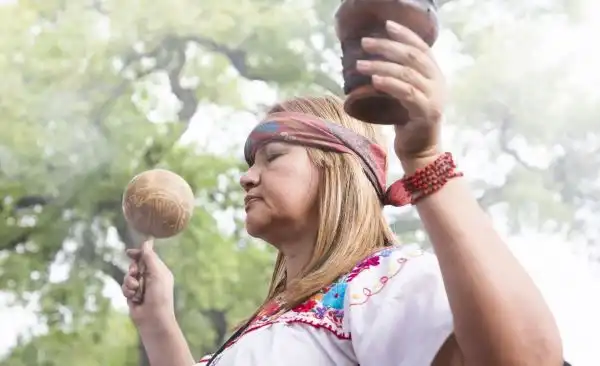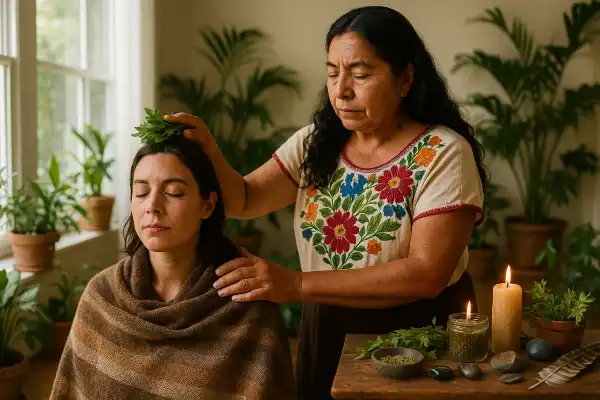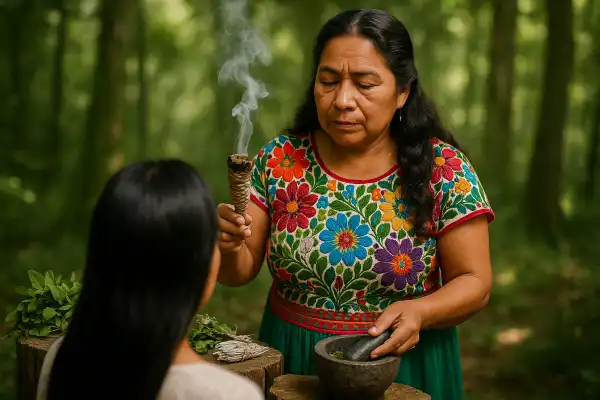Curanderismo cultural significance runs deeper than healing practices alone, representing a profound expression of indigenous resistance, community identity, and spiritual continuity that has survived over five centuries of cultural suppression. Many people seeking to understand our healing traditions find themselves drawn not just to the remedies and rituals, but to the powerful cultural forces that have kept these practices alive through generations of marginalization.
As someone who has spent decades studying and practicing within the curandera lineage, María del Pilar Fernández believes that curanderismo’s cultural significance lies in its role as a living bridge between ancestral wisdom and contemporary survival. She recognizes that for many Mexican and Mexican American communities, curanderismo represents far more than alternative medicine—it embodies cultural sovereignty, spiritual autonomy, and the preservation of indigenous knowledge systems that colonization sought to erase.
Curanderismo cultural significance
Curanderismo holds profound cultural significance as both a preservation mechanism for indigenous Mexican identity and a form of resistance against centuries of cultural suppression. This syncretic healing system, born from the intersection of indigenous practices and Catholic spirituality during Spanish colonization, has become a cornerstone of cultural identity that celebrates specific healers and preserves traditional knowledge through oral transmission.
Cultural identity and community cohesion
The practice fosters community cohesion through group rituals that emphasize the spiritual needs of individuals, often serving as a cathartic experience for participants while offering explanations for personal challenges and sometimes functioning as a means of social control that reflects underlying moral beliefs. Within Mexican and Mexican American communities, curanderas and curanderos serve as more than healers—they function as cultural anchors who maintain connections to ancestral ways of knowing and being.

Each curandera has a distinctive practice that is most often learned within the context of her family, community, elder, or tribal nation, with practitioners regularly found in Mexican-American neighborhoods of the United States—usually an older woman who has knowledge of herbs and cultural remedies, and who may also have other gifts and abilities such as clairvoyance. This localized nature of practice strengthens neighborhood bonds and creates networks of cultural knowledge that span generations.
Resistance and cultural survival
The healing tradition, born of the interaction between Indigenous, Spanish, West African, Arab and Asian medicine ways in Mexico more than 500 years ago, has been actively suppressed by dominant culture—so much so that generations of curanderas practiced in secret, especially in Arizona. There was significant work done to actively suppress curanderismo and Mexican culture in general, with efforts to assimilate communities in Texas and Arizona, though New Mexico maintained a stronger acceptance where “this is nuestra medicina” and there’s not nearly the negative stigma found elsewhere.

The cultural significance of curanderismo extends to its role in preserving indigenous knowledge systems that were systematically targeted for elimination. The pressure to conceal family traditions and adapt to mainstream American culture left many Chicanos feeling rudderless, with a fractured sense of identity. However, curanderismo provided a pathway for maintaining cultural connection even when practiced in secrecy.
Border culture and transnational identity
The preservation of these traditions and culture as communities exist on the border means survival itself, with curanderismo serving as a bridge that connects and holds cultures and generations together rather than a division or barrier. Today, variations of curandero practices are commonly practiced throughout Mexico as far south as the states of Oaxaca and Morelos and spanning far north, past the Rio Grande and even into Colorado, coexisting with modern biomedicine despite a long history of the repression of indigenous peoples.
For Latino communities facing healthcare challenges, curanderos provide services to Spanish communities where they can communicate better about diagnoses and treatment, unlike hospitals or healthcare workers that might have difficulty with language barriers and complex medical terminology. This accessibility becomes particularly significant for undocumented immigrants who may avoid formal healthcare systems due to fears about their legal status.
Religious syncretism and spiritual autonomy
As a result of colonization, curanderismo today is usually a synthesis of Mexican indigenous culture and beliefs, and depending on the curandera’s religious, cultural, and tribal background, it may also have Catholic, African, or other influences. The use of Catholic prayers and other borrowings is often found alongside native religious elements, with many curanderos emphasizing their native spirituality in healing while being practicing Catholics.
This religious flexibility represents cultural significance beyond simple adaptation—it demonstrates indigenous communities’ ability to maintain spiritual sovereignty while navigating imposed religious systems. The integration of Catholic elements alongside indigenous practices created a form of spiritual resistance that allowed communities to preserve their cosmologies within acceptable frameworks.
Intergenerational knowledge transmission
As with many traditional systems, curanderismo is passed down orally—no guiding text, no dogma, no board exam to pass. This oral transmission system carries immense cultural weight, as it requires intimate relationships between elders and younger community members, ensuring that not only healing techniques but also cultural values, worldviews, and community bonds are maintained across generations.
Many practitioners discover their calling through family connections, with shifting cultural views making it safer for healers to come “out of the curandera closet” and for those sifting through memories of family remedios and curas to reconnect with their roots. This reconnection process often represents a broader cultural reclamation as Mexican American communities seek to restore connections to their indigenous heritage.
Modern cultural revitalization
Modern curandero movements celebrate specific healers who have died but whose practices and methods have been preserved, tied with the resurgence of indigenous identity promoted by the indigenismo movement for social change and activism in Mexico. Albuquerque became one of the big hot spots of Chicano activism and of Chicano identity, with Indigenous revitalization making it no coincidence that curanderismo is so strong and prevalent and accepted in New Mexico.
Universities now offer courses in curanderismo, marking a significant shift from suppression to academic recognition. The teaching of curanderismo continues to expand across the Southwest and at The University of New Mexico, representing an extraordinary way to heal that’s been mentioned in history books and headlines for generations.
Healthcare accessibility and social justice
Traditional healing practices among Mexican and Mexican Americans may be as high as 50-75% in some parts of the United States, highlighting curanderismo’s continued relevance as communities navigate healthcare systems that may not address their cultural, linguistic, or economic needs. The practice remains relevant, particularly in areas with limited access to conventional healthcare, and is often integrated with modern medical practices to create a holistic approach to health.
The cultural significance here extends to questions of medical sovereignty and the right of communities to maintain their own healing traditions alongside or instead of Western biomedicine. Rather than an either/or approach, contemporary curanderas seek to educate health care providers about Mexican Indigenous healing ways so that practitioners of Western conventional medicine may become attuned to the cultural needs of their Mexican and Indigenous patients.
Disclaimer
Please note that Maria is not a physician, psychologist, or nurse. These culture-specific spiritual healing services are not meant to replace medical or psychological diagnosis and treatment. It is recommended that you see a licensed physician or licensed health care professional for any physical or psychological ailment you may have.
Last autumn, María encountered Daniela, a young woman from Guadalajara who had recently immigrated to Oaxaca City for work. Daniela carried a profound sadness that seemed to permeate her entire being—her shoulders curved inward as if protecting her heart, and her eyes rarely met others’ gaze. Through gentle conversation, María learned that Daniela felt disconnected not only from her family but from her own cultural roots, having spent years in the United States where she felt pressure to abandon her traditional ways.
María began with a gentle limpia using white sage and copal, calling upon the four directions and asking the ancestors to guide Daniela healing. As the sacred smoke enveloped them both, María spoke quietly about the importance of honoring our cultural heritage as medicine for the soul. She prepared a té of toronjil and manzanilla for Daniela’s emotional overwhelm, while teaching her about the significance of maintaining connections to our ancestral ways even when living far from home.
Over several sessions, María guided Daniela through the practice of daily gratitude to her ancestors and helped her create a small altar honoring her grandmother’s memory. She explained how curanderismo isn’t just about healing illness—it’s about healing the disconnection from our cultural identity that modern life often creates. Through learning simple remedios her grandmother might have used and understanding the deeper cultural significance of these practices, Daniela began to reclaim a sense of belonging and purpose that had been lost in her journey between worlds.

